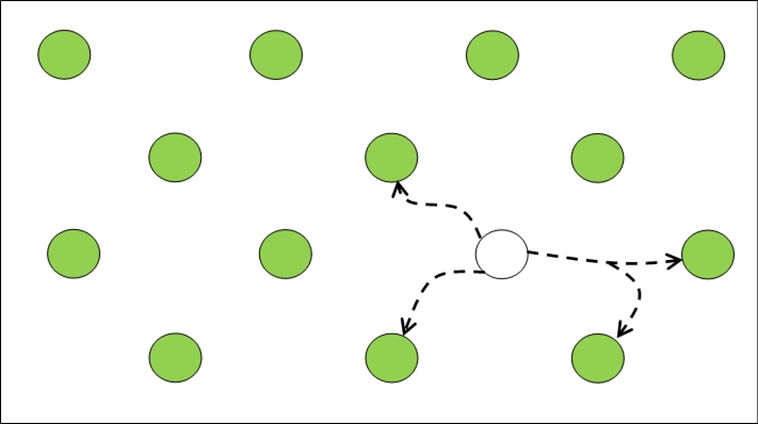
An (Un)Reasonable Hypothesis for Bilaterian Evolution
Abstract
This article takes a reasoned approach to identify the biases and fallacies within the subsequent mentioned paper, and extorts and instructs the reader to do the same, not only concerning the article mentioned but concerning all such scientific papers.
A journal article titled, “The Origin of the Animals and a ‘Savannah’ Hypothesis for Early Bilaterian Evolution,” postulates an evolutionary connection between and a pathway from “simple” biota organisms found in the Edicaran “period” rock layers, and the more complex bilaterian animals found in the Cambrian “period” (a.k.a., Cambrain Explosion) rock layers.
To Be Reasonable Or Not To Be Reasonable?
In order to answer this question sufficiently, a detailed philosophical approach will be taken rather than purely evidential or scientific. There are several elements to consider when dissecting this or any other “scientific” paper: 1) summarize what the hypothesis proposes and attempts to explain and understand, in this case, what the “Savannah Hypothesis” is; 2) dissect the language of the paper; 3) discuss naturalistic (often confused with scientific) dogma; and 4) demonstrate why the proposed hypothesis is not viable.
The “Savannah” Hypothesis for Bilaterian Evolution
The paper admits that explaining how early animals evolved is a problem, especially concerning the rise of bilaterian animals during what evolutionists call the “Cambrian Explosion.” Two of the main questions that the authors try to answer are, Why did bilaterians start burrowing, and how did the ability to burrow evolve? The authors attempt to demonstrate a beneficial relationship between the Ediacaran biota and Cambrian bilaterians, in reference to how the Ediacaran biota may have affected the development of the bilaterians modes of locomotion and ability to burrow.
The Ediacaran biota thus played an enabling role in bilaterian evolution similar to that proposed for the Savannah environment for human evolution and bipedality.1
Before describing the “Savannah” Hypothesis for Bilaterian Evolution, defining a few terms and understanding a few concepts is necessary. A bilaterian is an animal that exhibits bilateral symmetry, meaning the animal has a discernible front, back, top, and bottom, and therefore left and right side. Examples of such animals are horses, fish, snakes, insects, and dinosaurs. Animals like starfish and sand dollars exhibit radial symmetry: they have a top and bottom but no discernible front and back or left and right side.
The “Savannah Hypothesis”
The modern Savannah environment is essentially a plain dotted with hills. The hills contain trees and other nutrient-rich resources compared to the rest of the plain. These areas contain a greater diversity of life forms than the surrounding “plain” plain. Imagine a blank piece of paper; this represents a plain. Polka dots are added and dispersed throughout the paper to represent the hills “dotting” the Savannah plain. Therefore, the dots represent increased resources: trees, other plants, nutrient-rich soil, insects, and other small animals (Figure 1).

Figure 1: Savannah plain “dotted” with hills acting as nutrient-rich sub-ecosystems
The Savannah Hypothesis attempts to explain the evolution of bipedal locomotion (i.e., walking upright). Simply put, it is thought that before bipedal locomotion evolved our supposed ancestors lived in these resource rich dots. However, over time, as resources became depleted these ancestors needed to move to a new resource-rich dot. This forced need prompted the development of a newer and faster form of locomotion. These supposed ancestors would need to travel these distances faster than others in order to get to the resource first and thus survive (Figure 2). This is however a hypothesis, because there is no experimental evidence.

Figure 2: Illustration of supposed ancestors moving to new resources
Bilaterian Evolution
The “Savannah” Hypothesis for Bilaterian Evolution proceeds to hypothesize that bilaterian evolution was enabled by Ediacaran biota. This Ediacaran biota essentially formed benthic communities of microbial mats. These supposed microbial mats would have acted as “islands” of resources on the bottom of the ocean floor. The ocean floor is analogous to the Savannah plain. And just as the dots on the Savannah represent a sub-ecosystem of increased resources within the Savannah, they also represent the microbial mats of increased resources that would have been found on the ocean floor. In addition to the mats lying on the ocean floor, some may have been buried under a thin layer of sediment. For a “simple” bilaterian, such as those seen in Ediacaran fossils, as their source of food runs out they must move to a new source of food, forming new means of locomotion or perhaps “learning” the behavior of burrowing in order to reach the food under the sediment.
This resource concentration may have made burrowing energetically viable, just as resource concentration on the savannah may have facilitated bipedality in early humans. A transition from early bilaterians living largely on the surface and feeding off mats that surrounded the Ediacara-style biota to true burrowing may have been facilitated by partial burial of such mats, with their indigenous fauna continuing to feed on them even when below the surface.2
What to Look for: “This May Possibly, I’m Thinking, Could Be Absolutely True.”
For “scientific” papers that purport molecules-to-man evolution, due to the inability to perform experiments, hypotheses about the past are purely speculative. The speculation becomes clear when scrutinizing the language used in these sorts of papers. Also it should be noted, at least in this case, what is proposed is simply a hypothesis about the past in which there can be no experimental confirmation. Therefore, what appears to be highly scientific is indeed not. It is simply a naturalistic explanation based on a materialistic worldview.
Readers should consider five language mechanisms when reading such published works: leading questions, evidence and facts, assumptions, admissions, and subjective language play important roles in these sorts of papers. For example, the present-day living animals’ observed behaviors and other qualities are superimposed onto the fossilized animals. Evidence is therefore mixed with assumptions to come to a conclusion. The use of admissions and subjective language prevent the author from being discredited or disproven. When papers focus on past events, there is no certainty of their veracity, especially since there is no way to experimentally test their assertions and ideas. This leaves them in the realm of hypotheses; therefore, they never reach the possibility of developing into a theory.
Leading Questions
A leading question is a form of a fallacy known as Begging the Question. A person committing a Begging the Question fallacy simply presumes what they are attempting to prove. An example would be, “What is the evolutionary path that links birds to dinosaurs?” First it can be seen that the question presumes that birds and dinosaurs are related. Then in order to confirm the perceived relationship, an evolutionary path is to be proven. Obviously, there would be no reason to prove an evolutionary path if there is no presumption that dinosaurs are the distant ancestors of birds.
The summary of the article asks a leading question: “Why, though, did the energetically expensive and functionally complex burrowing mode of life so typical of later bilaterians arise?”3
The authors assume an evolutionary path for certain bilaterian behaviors and then attempt to prove how these behaviors (i.e., burrowing) evolved. In such “scientific” papers the leading question is very much the thesis.
Evidence/Facts
When reading research papers, especially in biology, it is good to separate what is actual evidence and what is the interpretation of that evidence. The issue arises because the evidence, such as fossils, does not come with a tag designating its age or any other information that would reveal how the animal lived. Fossils certainly cannot tell us how a certain behavior came to be by simple laboratory tests. Fossils exist in the present and the only information they provide is that the animal died and was buried by sediment. Another form of evidence used is the observation of known living creatures. In the case of the paper in question, this refers to what is known about sponges, xenophyophores, and choanoflagellates. Whole behaviors can be observed of these animals in the present; therefore we can safely consider these facts, or evidence, but only as applied to those living creatures.
Assumptions
“Scientific” papers, especially in regards to the biological past, can be strewn with assumptions. Since the “Savannah” Hypothesis for bilaterian evolution is merely presented as a hypothesis, there are more assumptions than facts. However, a problem arises when the assumptions are conflated with actual facts and observations (evidence). An assumption is an idea or belief that is postulated or supposed. This is where presuppositions come in; based on one’s prior beliefs, assumptions and interpretations are made about evidence and facts. So if a person starts with a false presupposition, then his assumptions and interpretations will more than likely be false as well. Biblical creationists presuppose the Bible’s veracity and therefore assume most fossils were formed during the Flood. However, based on materialism and naturalism, evolutionists presuppose molecules-to-man evolution is true; they therefore assume fossils were buried slowly over long periods of time and lived in a certain order in history, based on their placement within the sedimentary layers. For example, it is assumed the Cambrian fossils came after the Ediacaran fossils because of their general order in the geologic column. What is almost never considered is the possibility that these two fossil “periods” were actually contemporaneous rather than separated by millions of years.
Admissions
An admission is defined as “an acknowledgment of the truth of something.”4 Admissions are used to disclose missing information or the challenges that exist with certain ideas presented; so they reveal how much is actually not known. The author actually starts the paper with an admission: “The earliest evolution of the animals remains a taxing biological problem, as all extant clades are highly derived and the fossil record is not usually considered to be helpful” [emphasis mine].5
Subjective Language
This involves language that is not certain or absolute. For example,
The early animals may have increased their genetic armoury directly via lateral gene transfer from their prey, and by co-option of adherence proteins involved in prey capture into the mechanism for multicellularity [emphasis mine].6
There is no certainty in this statement because not all the information is readily available. The statement can be considered true or false depending on one’s perspective and level of knowledge. For sake of argument, let’s say the “early animals” did indeed increase their genetic diversity through gene transfer and co-option of adherence proteins. Even though the author did not witness this, it is considered a possibility,7 so the above statement can be considered true. On the other hand let’s say the “early animals” never actually changed, so what is seen in the fossil record is how they have always existed. Once again, the author did not witness or consider the animals never changing as a possibility, but still expresses the above statement; it therefore can be considered false. Subjective language is a tool in order to make something sound true without actually being true. Other examples of subjective language are words and phrases such as most likely, probably, at least, seems to be, appears to be, somewhat resembles, might best be considered, possibly, giving the impression, and so on. If subjective language is present in a statement, then the author cannot guarantee its veracity.
Here is an example from the paper that mixes evidence, assumptions, admissions, and subjective language:
Given the general presence of sexual reproduction in eukaryotes and in particular in animals, and the likelihood of sexual reproduction in choanoflagellates based on the presence of meiosis genes (Carr, Leadbeater & Baldauf, 2010—even if sexual reproduction has never been observed directly), these stem animals and eumetazoans were also likely to reproduce sexually, and thus to have at least a mobile sperm stage.8
When remarks, such as the one above, are broken down, the selective language can be plainly comprehended and analyzed.
- Evidence/Facts: “Given the general presence of sexual reproduction in eukaryotes and in particular in animals. . . .” Since this is an observed phenomenon that can be repeated, it is considered a fact.
- Assumption with subjective language: “. . . and the likelihood of sexual reproduction in choanoflagellates based on the presence of meiosis genes.” It is assumed choanoflagellates are capable of sexual reproduction, but the author is careful not to make an absolute statement by inserting “likelihood.”
- Admission: “. . . even if sexual reproduction has never been observed directly.” This is the reason the author uses subjective language in the prior assumption.
- Assumption with subjective language: “These stem animals and eumetazoans were also likely to reproduce sexually, and thus to have at least a mobile sperm stage.” This assumption uses the above evidence, even though it is not necessarily related, to come to a conclusion and again uses subjective language: “likely to.”
Naturalistic Dogma
The ascribed belief that is purported in the paper in question is naturalistic evolution. This belief assumes that all life originated from non-life and that “simple” single-celled organisms changed over time into more complex multi-cellular organisms. These then gave rise to “ancient” animals and plants which then gave rise to the eventual animals, plants, and humans alive today (a.k.a., molecules-to-man evolution). Naturalism assumes that all living things—past, present, and future—arose, changed, and existed by purely material means completely, and arbitrarily, excluding any supernatural cause, such as God. It is labeled as dogma because molecules-to-man evolution is taught, nay preached, from elementary school through college and beyond as being absolutely true with no question about its veracity. Therefore, papers such as this one adhere to a belief system that determines the assumptions and conclusions of the author, regardless of evidence.
Naturalistic dogma becomes more apparent when trying to figure out events of the past; and past events cannot be replicated in a laboratory. The only way to know how something transpired in the past is through an eyewitness account. But even then, we have to put faith in the eyewitness and that his account is indeed true.
Unfortunately, this naturalistic dogma, disguised as objective science, has infiltrated scientific inquiry, especially in biology. The science being taught and practiced in biology at the university level can be quite subjective. In one personal experience, a PhD student admitted that in biology (with respect to past, unobserved events) one can collect as much evidence and data as possible, but in the end that person “pretty much gets to make up whatever they want.” Unfortunately, this is still sold as being objective and scientific.
There’s Just No Way to Know
If someone were to point to this article on bilaterian evolution as an explanation for the evolution/origin of animals, the best question to pose would be, “Are the contents of this article absolutely true?” Either answer given is a no-win. If the answer is “yes” then all the assumptions, admissions, and subjective language should be pointed out. If there is so much that cannot be known, then how can it be absolutely true? If the answer is “no,” then the discussion has ended on a self-refuting point. The only possible logical answer to the origin of animals and their behavior is the One Who created them.
Footnotes
- Graham E. Budd and Sören Jensen, “The Origin of the Animals and a ‘Savannah’ Hypothesis for Early Bilaterian Evolution,” Biological Reviews (2015): 1, doi: 10.1111/brv.12239.
- Ibid., 20.
- Ibid., 1.
- Dictionary.com, s.v. “Admission,” accessed February 4, 2016, http://dictionary.reference.com/browse/admission.
- Budd and Jensen, “The Origin of the Animals and a ‘Savannah’ Hypothesis for Early Bilaterian Evolution,” 1.
- Ibid., 4.
- In reality this is not genetically possible; it is simply assumed a possibility here for the sake of argument.
- Budd and Jensen, “The Origin of the Animals and a ‘Savannah’ Hypothesis for Early Bilaterian Evolution,” 5.
Recommended Resources

Answers in Genesis is an apologetics ministry, dedicated to helping Christians defend their faith and proclaim the good news of Jesus Christ.
- Customer Service 800.778.3390
- © 2024 Answers in Genesis




